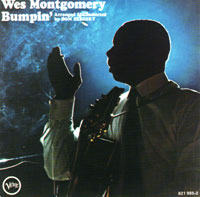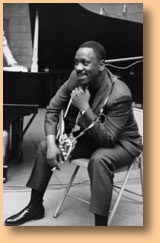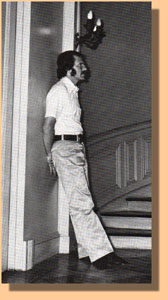

|
Soundclip:
|
| See Steve's Hand-Written Solo transcription |
|
Wes Montgomery's
solo on:  Though I have offered this thought before, perhaps this very recording was the beginning of the "Smooth Jazz" era, long before some odious marketing person had to invent that term. Certainly Creed Taylor's production style had a great deal to do with what was to come. The 'formula' was rather simple, one takes at least two very familiar compositions, wraps them in a very pretty sonic package and people, ordinary people, not 'true' Jazz fans, will respond. On this LP, the big 'hit' was Wes' wonderful interpretation of Johnny Mandel's "The Shadow of Your Smile." But no less special was his treatment of the great Van Heusen-Burke standard, "Here's That Rainy Day." And, as was usual for this period, Broadway was represented by the gorgeous tune, "A Quiet Thing." My favorite vocal version of that tune was recorded by Morgana King. If Creed Taylor had a 'formula,' perhaps it could best be verbalized this way: Though I have offered this thought before, perhaps this very recording was the beginning of the "Smooth Jazz" era, long before some odious marketing person had to invent that term. Certainly Creed Taylor's production style had a great deal to do with what was to come. The 'formula' was rather simple, one takes at least two very familiar compositions, wraps them in a very pretty sonic package and people, ordinary people, not 'true' Jazz fans, will respond. On this LP, the big 'hit' was Wes' wonderful interpretation of Johnny Mandel's "The Shadow of Your Smile." But no less special was his treatment of the great Van Heusen-Burke standard, "Here's That Rainy Day." And, as was usual for this period, Broadway was represented by the gorgeous tune, "A Quiet Thing." My favorite vocal version of that tune was recorded by Morgana King. If Creed Taylor had a 'formula,' perhaps it could best be verbalized this way:And so, if this hold true, the familiar names included those of: Roger Kellaway: Piano, Ron Carter: Ac. Bass, Candido Camero: Congas, and either Grady Tate or Helcio Melito: Drums. Though I am still not any 'expert' by any stretch of the imagination, I do know that this interpretation of "Con Alma" was played with what Latin players call an "Afro" feel. I know this because I recognized Candido's very distinctive conga pattern. It is because of this that, it could be possible that Helcio Melito was playing drums on this particular track, though there are no clear individual track credits are given. What is also reassuring for the Jazz fan is that Wes' original tunes were also always hugely popular with his fans. People loved to hear "Bumpin'" as much as any of the standards or 'Pop' tunes. "Con Alma" which means "With Soul" was composed by trumpeter Dizzy Gillespie, "Con Alma" and adheres to the basic A-A-B-A, 32-bar song form. Harmonically, the tune seems to be melodically driven, but during the [A] sections the descending bass lines in bars 1-3 and 5-7 also become crucial to flavor.  As is fairly typical for me, I only bothered to transcribe the single-note portion of Wes' solo which occupies just one chorus. His octaves only last for 2 [A] sections before the melody returns at [B]. Like most tracks during Wes' Verve period, this one last for only 3:25. In the days of the LP, everyone who was concerned with releasing high-end, audiophile recordings knew that it was important to try to keep each side of the LP under 19-minutes in length so that you could get the 'hottest' pressing, and you could then compete at radio. This is why now, in the CD age, you see so many 2-fers, meaning two LPs placed together on one CD. Now, this all becomes a nice bonus. As is fairly typical for me, I only bothered to transcribe the single-note portion of Wes' solo which occupies just one chorus. His octaves only last for 2 [A] sections before the melody returns at [B]. Like most tracks during Wes' Verve period, this one last for only 3:25. In the days of the LP, everyone who was concerned with releasing high-end, audiophile recordings knew that it was important to try to keep each side of the LP under 19-minutes in length so that you could get the 'hottest' pressing, and you could then compete at radio. This is why now, in the CD age, you see so many 2-fers, meaning two LPs placed together on one CD. Now, this all becomes a nice bonus."Con Alma" can be a tricky tune to notate properly, because you are starting out on an Emaj7 chord, which is a sharp key, and then you move through a sequence of chords which takes you through flat keys like: Db minor; Eb major; Db major; and Bb minor. So, I tried to notate the transcription using flats, except for those moments in E major. From a linear perspective, the most challenging moments, when improvising over this tune, occur during bars 1 and 5 of the [A] sections. It becomes tricky because, in general, the chords are moving at pace of a change every two beats. In bar 1, you see Wes negotiate the Ab7/Eb chord by simply spelling out an Ab triad. In bars 5-6, he, in essence, plays through all three changes by utilizing the Bb minor pentatonic[Bb, Db, Eb, F, Ab]. In the 2nd [A] section, Wes treats that Ab7/Eb chord by centering his idea around the note Db. In bar 5, he outlines notes from an F7 chord: F, C, and Eb with Gb(the b9) used to pass to the Bbm7 chord. In [A3], he negotiates the Ab7/Eb by spelling out notes from Ab7b9[A-natural, F#/Gb, and Eb] before passing to the Dbm7. In bar 5, he simply takes a breath, and uses F-Eb to anticipate the Bbm7 chord's arrival in bar 6. I think that one of the most exciting elements of this particular solo is Wes' usage of double-time phrasing which appears here in the form of 16th-notes. The solo begins with Wes Montgomery's wonderful sense of lyricism and space. The first [A] section is all stated in 8th-notes, and spans a range from his low Bb, all the way up to the high 'G'.  Then suddenly, yet with great ease and fluidity, Wes switches to double-time at [A2] and you begin to see the complex 16th-note sub-divisions. It is interesting to note, or to speculate, that Wes seems to be alluding to another Dizzy Gillespie tune, "Blue 'n' Boogie" in his opening phrase. Perhaps it is because of this particular tempo that, where the opportunity presents itself for alterations during the V7-Imaj passages, you see very, very few of the altered notes. In other words, even for the great Wes Montgomery, this is a very diatonic solo. You see many of Wes' typical arpeggiated passages and chromatic passing tones are put to use more than the kind of chromaticism that colors most Jazz lines. Examples of these arpeggios appear in [A2] during bar 7; in [B] during bars 3, 5-6, and 7; and in [A3] during bar 4. Where the alterations are concerned, there is a very lyrical passage in [A3], bar 7 where he alludes to G7b9 by touching upon Ab-B before the cadence to Cmaj7 via G-E. Then suddenly, yet with great ease and fluidity, Wes switches to double-time at [A2] and you begin to see the complex 16th-note sub-divisions. It is interesting to note, or to speculate, that Wes seems to be alluding to another Dizzy Gillespie tune, "Blue 'n' Boogie" in his opening phrase. Perhaps it is because of this particular tempo that, where the opportunity presents itself for alterations during the V7-Imaj passages, you see very, very few of the altered notes. In other words, even for the great Wes Montgomery, this is a very diatonic solo. You see many of Wes' typical arpeggiated passages and chromatic passing tones are put to use more than the kind of chromaticism that colors most Jazz lines. Examples of these arpeggios appear in [A2] during bar 7; in [B] during bars 3, 5-6, and 7; and in [A3] during bar 4. Where the alterations are concerned, there is a very lyrical passage in [A3], bar 7 where he alludes to G7b9 by touching upon Ab-B before the cadence to Cmaj7 via G-E.If I might focus on one technical aspect of the guitar, I would like you to take a look at bars 5-6 of [B]. Specifically, I'm referring to the wonderful 3-octave arpeggio of a very basic E major triad, which Wes executes with great precision. An arpeggio such as this, where each note of the triad is preceded by its chromatic lower neighbor: D#-E; A#-B; and G-natural-G#. Wes travels from the high 'E' on his top E-string all the way down to his open low E-string. A passage like this requires a lot of practicing and a sense of just where you are going to make your position shifts. Firstly, lets look at how Wes vaults up to this arpeggio. If you look at the 2nd-half of beat 1 in bar 5, that F# is played on the B-string(on the 7th fret) with the E and the D# being played on the G-string. The rest should follow logically in that position. The first portion of the arpeggiated passage: E-B-G# would probably be best executed in the area of the 12th fret. Once the the G# has been played on the G-string, this is where I would make my position shift. From there, I would drop down to the 8th fret, still on the G-string, to play D#-E, and then down to A#-B on the D-string, while still in that area.  Then, I would make another position shift, while still on the D-string, moving down to G-natural to G#, and dropping down to the A-string for D#-E, and A#-B would be played in that area[around the 5th-7th frets] on the low E-string. The final G-G# down to low E are, of course, played on the low E-string again. Give this approach a try and see how it feels. If it does not suit you best, try making the position shifts in a different manner. Once you've decided on an approach, practice it daily, as an exercise, only playing it as slowly as it takes to execute it to perfection. Then, as your facility improves, move up the tempo on your metronome!!! You don't have a metronome? Well, it's time to get one!!! Then, I would make another position shift, while still on the D-string, moving down to G-natural to G#, and dropping down to the A-string for D#-E, and A#-B would be played in that area[around the 5th-7th frets] on the low E-string. The final G-G# down to low E are, of course, played on the low E-string again. Give this approach a try and see how it feels. If it does not suit you best, try making the position shifts in a different manner. Once you've decided on an approach, practice it daily, as an exercise, only playing it as slowly as it takes to execute it to perfection. Then, as your facility improves, move up the tempo on your metronome!!! You don't have a metronome? Well, it's time to get one!!!In any Wes Montgomery solo, one should not have to look too far to find references to the blues language. In that regard, the "Con Alma" solo is no different. You can hear bluesy phrases during [A] briefly in bar 7; and in [A2] during bars 7-8. In bars 1-2 of [B] while Wes is playing over the Cm7b5 sound, he is, in essence, employing notes from the C blues scale[C, Eb, F, Gb, G, Bb]. This is a way of giving some warmth to a chordal sound that some player find to be rather cold. Often times, players will also use Eb minor pentatonic[Eb, Gb, Ab, Bb, Db] and then making it a 'blues scale' too by adding in an A-natural if the mood strikes. For some, Wes Montgomery's Verve and A&M years will always remain a creative disappointment because of some of the reasons we have addressed above. However, to dismiss them entirely as some form of 'fluff' is not at all fair. Wes always remained a great artist and, his ability to state melodies with love, grace, and care never wavered. Within whatever space he was given to solo, his improvisations always made beautiful musical sense and they were blessed with his swinging phrasing. Let us not forget about his impeccable tone, the warmth of his guitar sound because, in some ways, that only improved in these settings. As always, we are hoping that you have enjoyed the "Con Alma" solo as presented here at Korner 1.
[Photos: Wes Montgomery seated in Van Gelder Studios
Don Sebesky at the Lotos Club, New York City, 1973 by Steve Salmieri Wes Montgomery in the moody lighting of Van Gelder Studios All Photos of Wes Montgomery by: Chuck Stewart] |